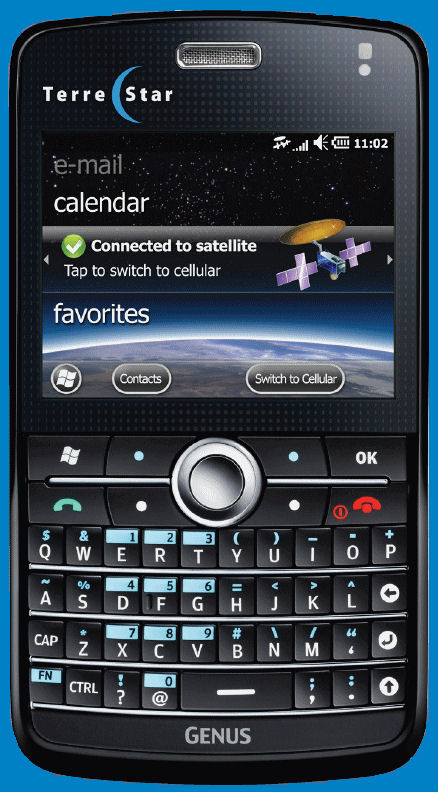|
New
Satellite Phones Still on the Horizon
In broadcast engineering, things typically take longer than expected,
especially when implementation of new technology is involved.
Apparently the same is also true of satellite telephone systems.
A year ago, NAB TechCheck reported on two Internet Protocol
(IP)-based satellite phone systems that were expected to soon
be available (see the July
27, 2009 issue of Radio TechCheck for additional background
information on these services). While still not up-and-running,
there have been new developments for each system.

TerreStar
Networks (Reston, Va., www.terrestar.com)
plans to offer a hybrid satellite/terrestrial mobile broadband
network that will provide voice, data and video services "…dedicated
to helping solve the critical communication and business continuity
challenges faced by government, emergency responders, enterprise
businesses and rural communities." TerreStar expects to offer
next generation mobile communications through a network of partners
and service providers to users who need "anywhere" coverage throughout
the United States and Canada.
Recently, TerreStar announced that commercial rollout of the TerreStar Genus dual-mode satellite-cellular smartphone (see photo) is expected to begin in September of this year. TerreStar unveiled the smartphone and its service partnership with AT&T in September 2009. The Genus service will be offered to customers in the United States, Puerto Rico and U.S. Virgin Islands.
The TerreStar-1 satellite was launched in July 2009 and according to TerreStar is "the world's largest and most powerful commercial communications satellite." TerreStar-1 is located in a geostationary orbital slot at 111.0 degrees west longitude and operates in the 2 GHz band (a second satellite, TerreStar-2, currently under construction, will be added to the system when completed). As shown in the map below, this satellite has a primary service area shaped to cover the 48 contiguous U.S. states and the area of southern Canada encompassing 90 percent of the population. The secondary service area includes the rest of Canada, Alaska, Hawaii, Puerto Rico and the U.S. Virgin Islands.
Satellite service is provided using approximately 500 spot beams across the North American coverage area, each about 100 miles in diameter. In February of this year, the initial on-orbit testing of the Ground Based Beam Forming (GBBF) technology used to create these spot beams was completed. According to TerreStar, this is the first two-way GBBF system to employ both ground-based calibration and beam forming. The system provides the flexibility to deploy over 500 spot beams and manage power and capacity as customer demand dictates.
Normally, the number of users and traffic load will determine
the particular beam configuration, however, during a national
emergency, the satellite is capable of supplying full spectrum
and over 100 times the regular power to any spot beam or customized
shaped beam. In particular, beams can be designed to cover incident
staging areas and evacuation routes according to the particular
disaster or incident. Additional information on the emergency
capabilities of the system are available in a white paper entitled
"A Highly Resilient Communications Solution for First Responders,"
available on the TerreStar Web page at www.terrestar.com/whitepaper.php.

It was
announced last week that the other satellite phone system, originally
called SkyTerra, has been "re-launched" as LightSquared (www.lightsquared.com),
a new nationwide 4G-LTE (Long Term Evolution) wireless broadband
network integrated with satellite coverage (using the L-band).
The satellites to be used in this service are planned for launch
in the 2010-11 time frame.

As the nation's
first wholesale-only integrated wireless broadband and satellite
network, LightSquared will provide wireless broadband capacity
to a diverse group of customers including: retailers, wireline
and wireless communication service providers, cable operators,
device manufacturers, Web players; content providers and many
others. The LightSquared network will allow these partners to
offer satellite-only, terrestrial-only or integrated satellite-terrestrial
services to their end users. The wholesale-only business model
ensures LightSquared has no conflict of interest with its customers.
The driving
force behind LightSquared is Philip Falcone, founder and chief
executive officer of Harbinger Capital Partners. Falcone has made
several investments through the Harbinger funds, including the
acquisition of SkyTerra Communications, Inc., to form LightSquared,
with the goal of "…meeting the explosive demand for wireless broadband
connectivity generated by new devices and the mobile Internet."
Falcone has partnered with telecommunications visionary Sanjiv
Ahuja, who will lead the LightSquared team as chairman and chief
executive officer. Ahuja was chief executive officer of the global
telecom giant Orange Group (www.orange.com/en_EN/group/)
from 2004 through 2007, during which Orange's customer base grew
from 48 million to more than 100 million subscribers globally.
In addition,
Nokia Siemens Networks, a leading supplier of telecommunications
equipment and services, has signed an 8-year agreement with LightSquared,
subject to final approval by both the Nokia Siemens Networks and
the LightSquared Boards. The agreement represents more than $7
billion over 8 years, and includes network design, equipment manufacturing
and installation, and network operations and maintenance. The
nationwide LightSquared network, to consist of approximately 40,000
cellular base stations, is expected to cover 92 percent of the
U.S. population by 2015. LightSquared is reportedly planning to
conduct trial market test runs in Phoenix and Denver early next
year.
|

